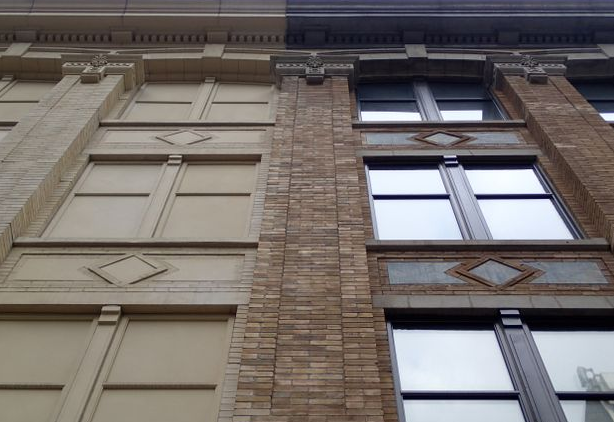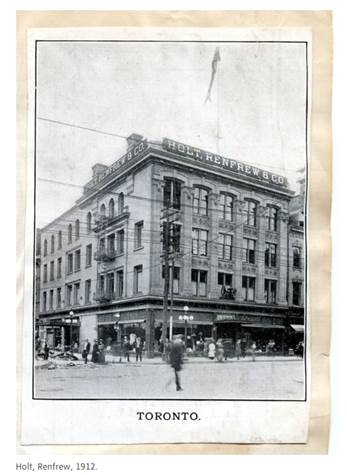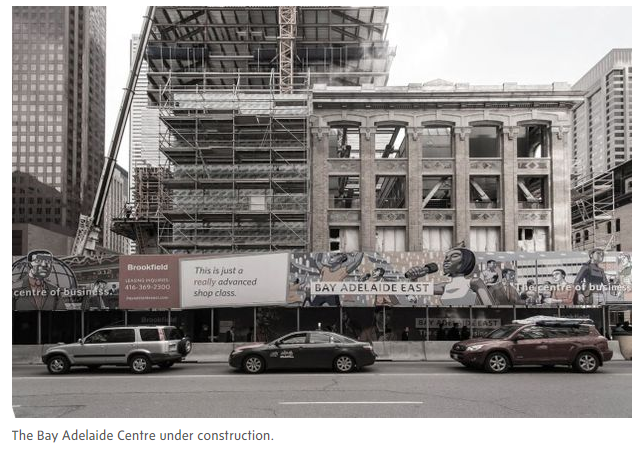
How Toronto’s architectural heritage was saved, the jigsaw way
Theglobeandmail.com
August 16, 2018
Dave Leblanc
For those who cry, “Toronto doesn’t respect its architectural heritage,” here’s a little story. A tale of moving heaven and earth – well, actually, brick, mortar, silicone moulds and some glass fibre-reinforced concrete – to create a heritage gateway at Yonge and Temperance Streets.
This tale also involves a ghost (albeit a friendly architectural one) and a developer who didn’t blink at some creative, costly solutions.

It all started in the late 1980s, when a noticeable shift occurred in how to treat those nasty heritage buildings that often got in the way of progress. At about the same time as the façade of the 1898 Wood Gundy building was being incorporated into the north wall of Scotia Plaza, and the nearby Robert Fairweather façade at 100 Yonge St. was being saved in situ, plans were drawn up to save the old Aikenhead’s Hardware building – formerly the Comet Bicycle Co. – on Temperance Street.
Aikenhead’s, a lovely, 1894, classical brick pile by E.J. Lennox (with alterations carried out in 1905), would be moved 120 feet east of its original location at 17 Temperance to make way for the Bay-Adelaide Centre (which would stall in the early 1990s recession and leave nothing but a “tombstone” elevator shaft for years – but that’s another story).
While nothing would happen for quite some time, the seeds for a heritage gateway had been planted.
In the autumn of 2011, the decaying-yet-beautiful 1897 Dineen Building (hats and furs were its specialty) at 2 Temperance St. was purchased by visionary developer Commercial Realty Group; by spring 2013, caffeine lovers were lining up at Dineen Coffee Co. and marvelling at the interior’s restored iron columns.
That set the stage for what happened next. “The idea was there could actually be a little nub of cute heritage buildings right at the corner of Temperance and Yonge,” said ERA Architects’ Michael McClelland, who, along with KPMB and Adamson Associates, has been working with Brookfield Properties on the Bay-Adelaide Centre since 2012.
Open this photo in gallery
Left to right: the Holt, Renfrew and Co. building; Aikenheads Hardware building- formerly the Comet Bicycle Company - on Temperance St.; the 1897 Dineen Building.

“Bay-Adelaide was approached by Deloitte,” he continued, “and they said: ‘We want to build a tower downtown, but we don’t want to be at Bay and Adelaide … we’ve got all these young kids and they want a campus where they’re connected to the street.'”
Since Adelaide was too busy and too noisy, it was decided to focus Deloitte’s portion of the new building toward the budding heritage corner, even though, explains Mr. McClelland, the Bay-Adelaide folk had “never thought of Yonge Street as a cool address.” The problem was, the south corner – there are only two corners that make up Yonge and Temperance – was occupied by an ugly, non-heritage, four-storey building that housed the massive mechanical systems for the entire complex, as well as a ground-floor retailer.
So, what to do? “Here’s where it gets really surgical,” laughed Mr. McClelland, as he picked up his Dineen coffee and looks out the window.

A half-block south, there sat what was left of the once-proud Elgin Block of three-and-a-half-storey buildings. Built in 1850, these Georgian commercial storefronts once marched up Yonge all the way from Adelaide Street to Temperance; William Lyon Mackenzie published The Weekly Sentinel from an office here. By the early part of the 20th century, however, a great many changes had been made to the block; the most dramatic occurred when Holt, Renfrew and Co. took over the southernmost, five-bay portion from Ryrie Bros. (diamond merchants who would partner with Birks). In 1910, Holt’s employed architect J. L. Havill to beef up the façade with much larger windows, a formal symmetry and expand to four-storeys. Holts would stay in the building until 1955.
Fast-forward a hundred years and that Holt Renfrew portion was all that remained. So, the decision was made to take the south façade facing onto Adelaide, and the Yonge façade, and turn them into giant jigsaw pieces that could be “knit back together” at the corner of Temperance. Using Holt Renfrew’s original 1910 drawings, the shop front would be recreated as well, complete with stamped, lead-coated copper and aluminum panels with an interlocking-circle pattern and ribbed-glass transom windows.
This is where the ghost enters our tale. Since there would now be a gap between the relocated heritage building and Deloitte’s new glass box, it was decided to take silicone moulds of the jigsawed building pieces (while still in storage) to create a “ghost building” of glass fibre-reinforced concrete, a material that picks up great detail, including pockmarks and hairline fractures in brick.
“Nobody had done this before, really,” Mr. McClelland explained. “But we thought it was interesting storytelling, because you could look at that and say ‘something’s happened here.’ … If we’d been true heritage advocates, we would’ve left a blank there and then would’ve had to do something modern there, but this is actually more fun.” As his inspiration, Mr. McClelland points to the work of contemporary artist Rachel Whiteread, who often takes negative space – such as that found behind different-sized books on a bookshelf – and makes a mould of it in order to cast it as sculpture.
“And amazingly, our client went for it,” he laughs. After choosing the right colour for this friendly ghost, the search for the right tenant began, which took some time. When the hip, colourful, Sud Forno by Terroni signed up, the “campus” was complete.
“Interestingly, once we did all these manoeuvres, which is really like a high-wire act, no one at the city noticed,” Mr. McClelland finished with a laugh.
Consider it noticed … end of story.
